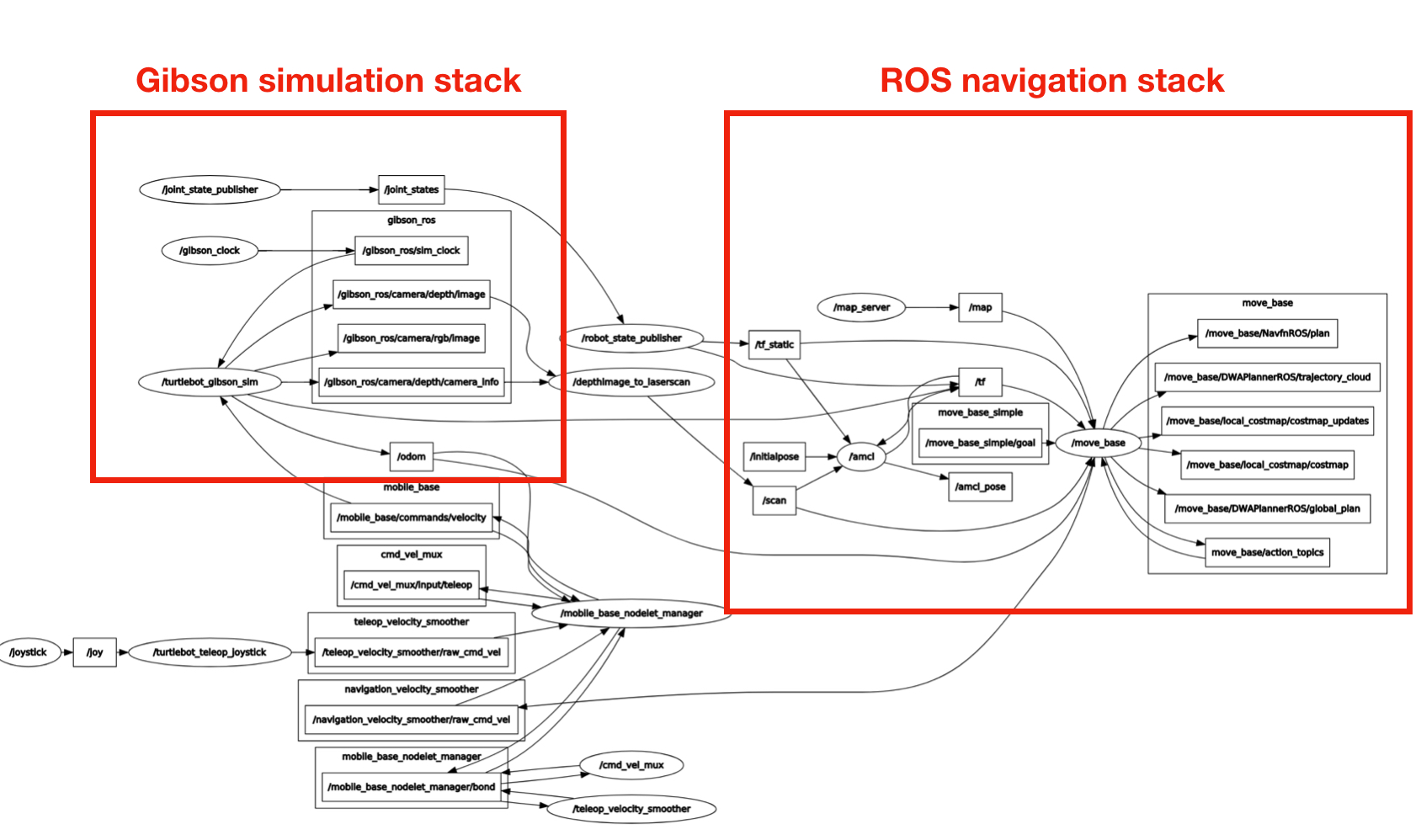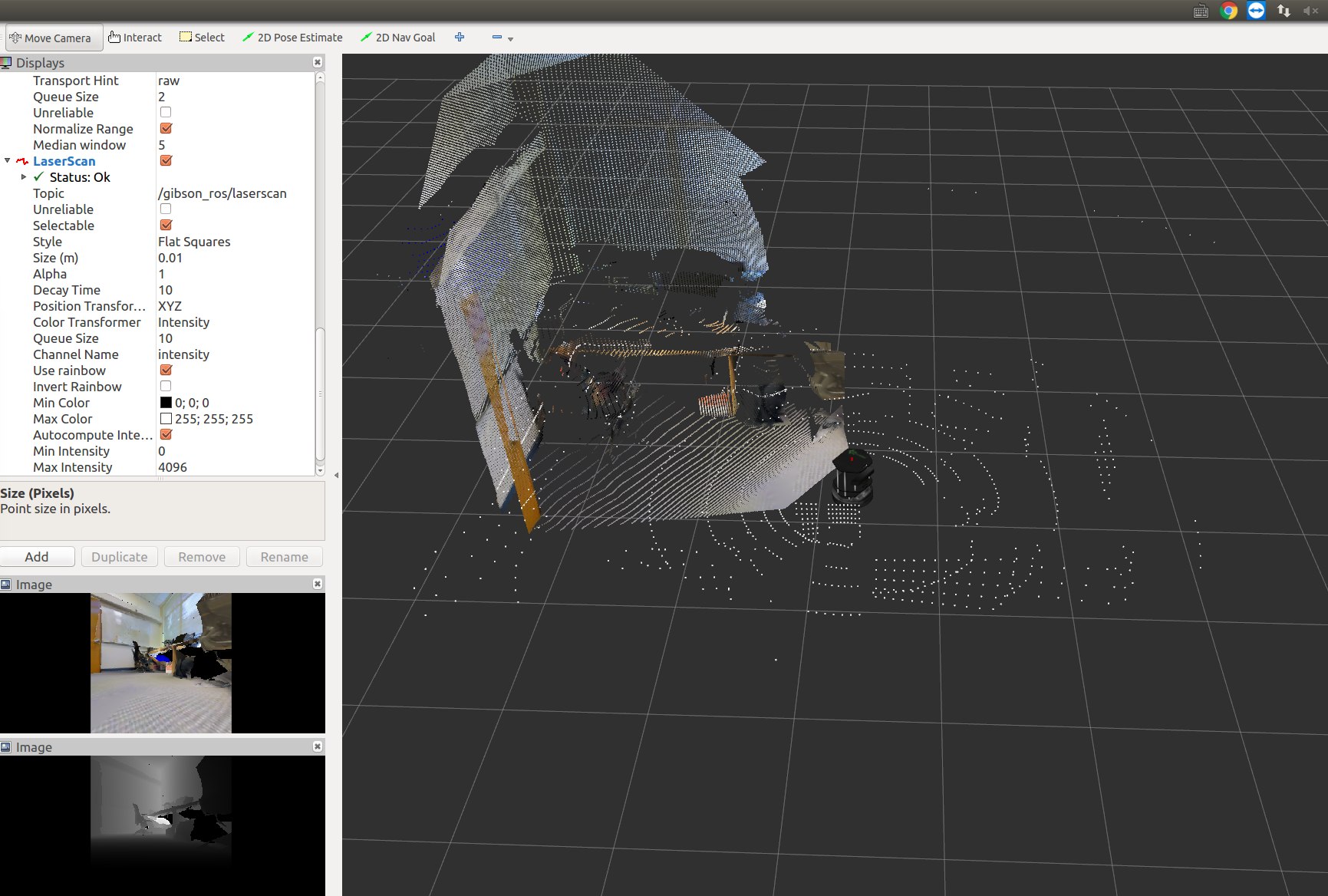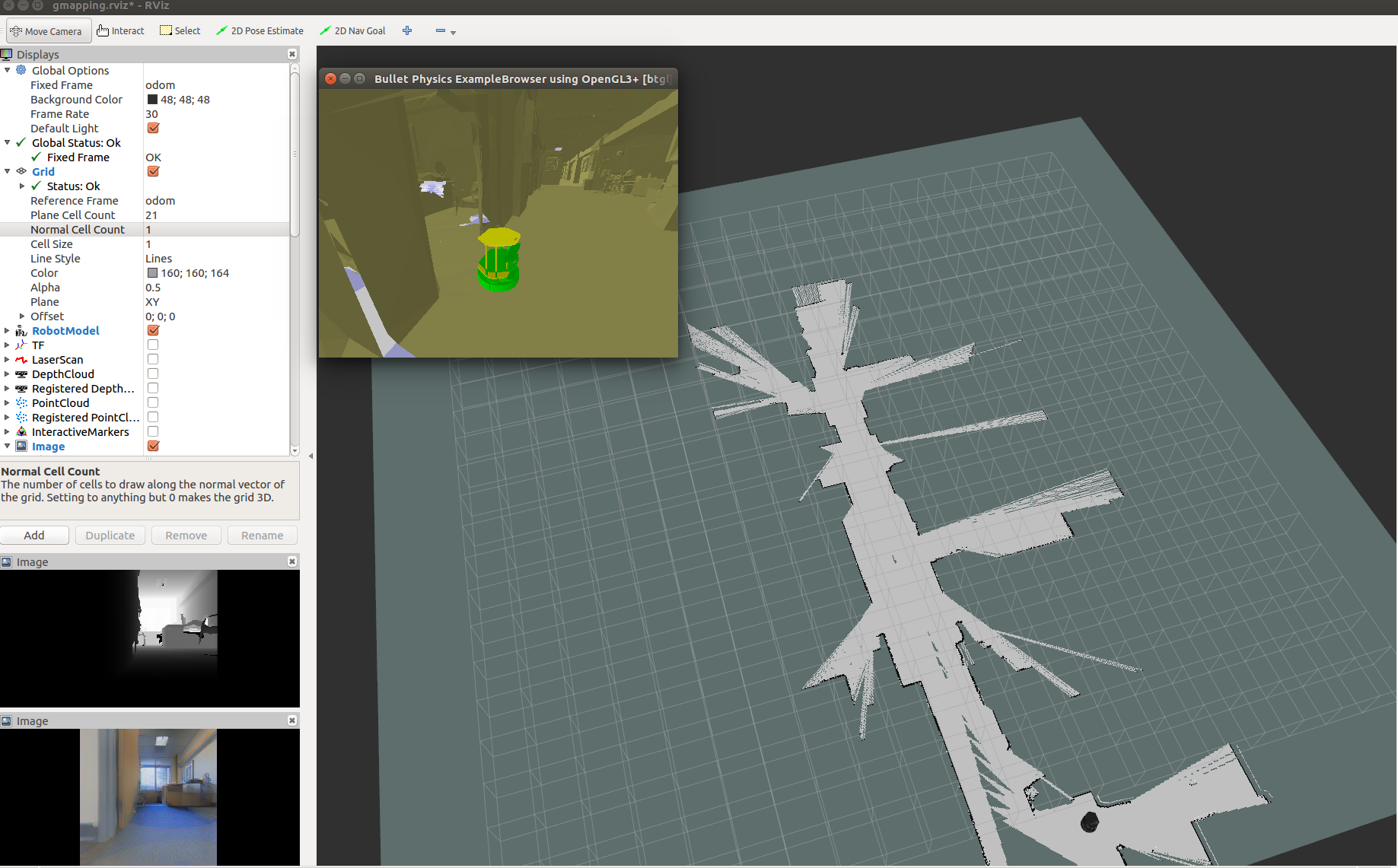ROS Integration¶
Introduction¶
ROS is a set of well-engineered software libraries for building robotics applications. It includes a wide variety of packages, from low level drivers to efficient implementations of state of the art algorithms. As we strive to build intelligent agents and transfer them to real-world (on a real robot), we need to take advantage of ROS packages to complete the robot application pipeline.
There are three key applications of integrating iGibson with ROS.
Benchmark existing algorithms in a controlled realistic simulation environment. This allows for comparing learning-based methods with classical methods in simulation environments.
Comparing robots in simulation with robots in the real world. In simulation, iGibson can simulate sensors of a robot and publish as messages. In the real world, a real robot publish sensor messages from onboard sensors. Therefore, it is possible to only change the message subscribed and benchmark the performance of downstream applications. This helps locate domain gap and debug algorithms.
Using ROS functions in simulation, such as many motion planning implementations.
The possibility of using iGibson with ROS is unlimited. As a starter, we provide an example of integrating iGibson with ROS for navigation. This is a ROS package integrates iGibson Env with ROS navigation stack. It follows the same node topology and topics as turtlebot_navigation package. As shown below, so after a policy is trained in iGibson, it requires minimal changes to deploy onto a real turtlebot.

Environment Setup¶
Preparation¶
Install ROS: in this package, we use navigation stack from ROS kinetic. Please follow the instructions.
Install iGibson from source following installation guide in python2.7. Note that ROS only supports
python2.7at the moment, so you need to create python2.7 virtual environment to install iGibson instead of python3.x.
git clone https://github.com/StanfordVL/iGibson --recursive
cd iGibson
conda create -n py2-igibson python=2.7 anaconda # we support python 2.7, 3.5, 3.6, 3.7, 3.8
source activate py2-igibson
pip install -e . # This step takes about 4 minutes
source deactivate # This step is important because we will NOT use <anaconda installation root>/envs/py2-igibson/bin/python
If you use anaconda for setting up python environment, some tweaks of
PATHandPYTHONPATHvariable are required to avoid conflict. In particular:For
PATH: conda related needs to be removed fromPATH
echo $PATH | grep -oP "[^:;]+" | grep conda ## Remove these paths from $PATH
For
PYTHONPATH:/usr/lib/python2.7/dist-packages/,/opt/ros/kinetic/lib/python2.7/dist-packages(ROS python libraries),<anaconda installation root>/envs/py2-igibson/lib/python2.7/site-packages(iGibson dependencies) and<iGibson root>need to be inPYTHONPATHin this exact order.
Create
catkin_wsfolder
mkdir -p ~/catkin_ws
Soft-link
igibson-rosfolder to yourcatkin_ws/srcand runcatkin_maketo indexigibson-rospackage.
cd <iGibson root>/igibson
ln -s $PWD/examples/ros/igibson-ros/ ~/catkin_ws/src/
cd ~/catkin_ws && catkin_make
Install
igibson-rosdependencies:
cd ~/catkin_ws
rosdep install --from-paths src --ignore-src -r -y
Sanity check¶
which python # Should give /usr/bin/python, NOT <anaconda installation root>/envs/py2-igibson/bin/python
python -c 'import igibson, rospy, rospkg' # Should run without errors
Running¶
In order to run iGibson+ROS examples, you will need to perform the following steps:
Prepare ROS environment
source /opt/ros/kinetic/setup.bash
source ~/catkin_ws/devel/setup.bash
Repeat Step 3 from Preparation: sanitize
PATHandPYTHONPATHHere are some of the examples that you can run, including gmapping, hector mapping and navigation.
roslaunch igibson-ros turtlebot_rgbd.launch # Bare minimal bringup example
roslaunch igibson-ros turtlebot_gmapping.launch # Run gmapping
roslaunch igibson-ros turtlebot_hector_mapping.launch # Run hector mapping
roslaunch igibson-ros turtlebot_navigation.launch # Run the navigation stack, we have provided the map
roslaunch igibson-ros turtlebot_gt_navigation.launch # Run the navigation stack with ground truth localization
The following screenshot is captured when running the bare minimal bringup example.

The following screenshot is captured when running the gmapping example.

Topics¶
Here are all the topics that turtlebot_rgbd.py publishes and subscribes.
Publishes:
| Topic name | Type | Usage |
|---|---|---|
/gibson_ros/camera/depth/camera_info |
sensor_msgs/CameraInfo |
Camera parameters used in iGibson, same for depth and rgb |
/gibson_ros/camera/rgb/image |
sensor_msgs/Image |
RGB image captured in iGibson |
/gibson_ros/camera/rgb/depth |
sensor_msgs/Image |
Depth image captured in iGibson, in meters, with dtype being float32 |
/gibson_ros/camera/rgb/depth_raw |
sensor_msgs/Image |
Depth image captured in iGibson, mimic raw depth data captured with OpenNI cameras, with dtype being uint16, see more here |
/gibson_ros/lidar/points |
sensor_msgs/PointCloud2 |
1-beam LiDAR scan captured in iGibson, in meters, with dtype being float32 |
/odom |
nav_msgs/Odometry |
The pose of base_footprint in odom frame, generated with groudtruth pose in iGibson |
/ground_truth_odom |
nav_msgs/Odometry |
The pose of base_footprint in world frame, generated with groudtruth pose in iGibson |
Subscribes:
| Topic name | Type | Usage |
|---|---|---|
/mobile_base/commands/velocity |
geometry_msgs/Twist |
Velocity command for turtlebot, msg.linear.x is the forward velocity, msg.angular.z is the angular velocity |
/reset_pose |
geometry_msgs/PoseStamped |
Direct reset turtlebot's pose (i.e. teleportation) |